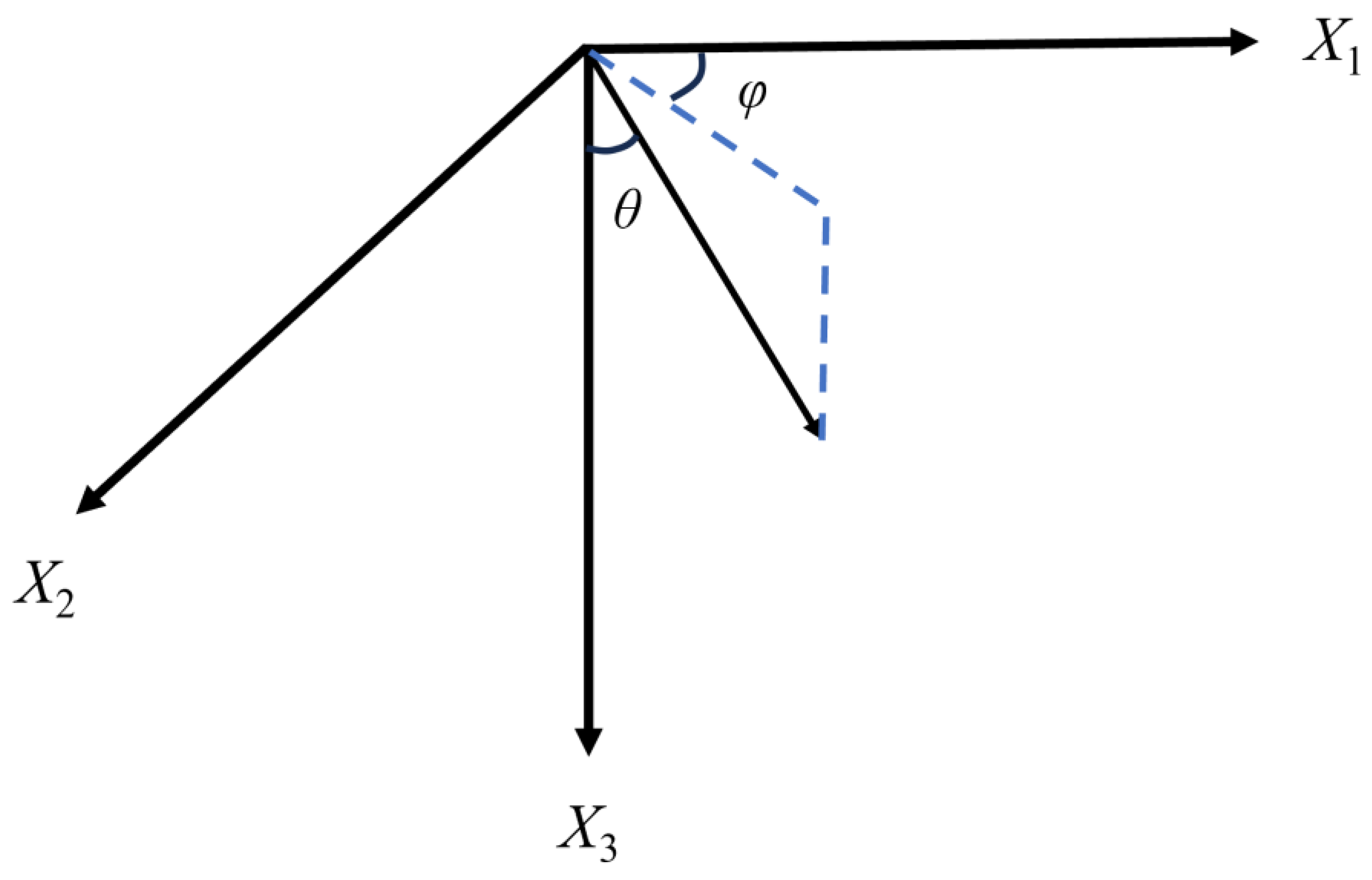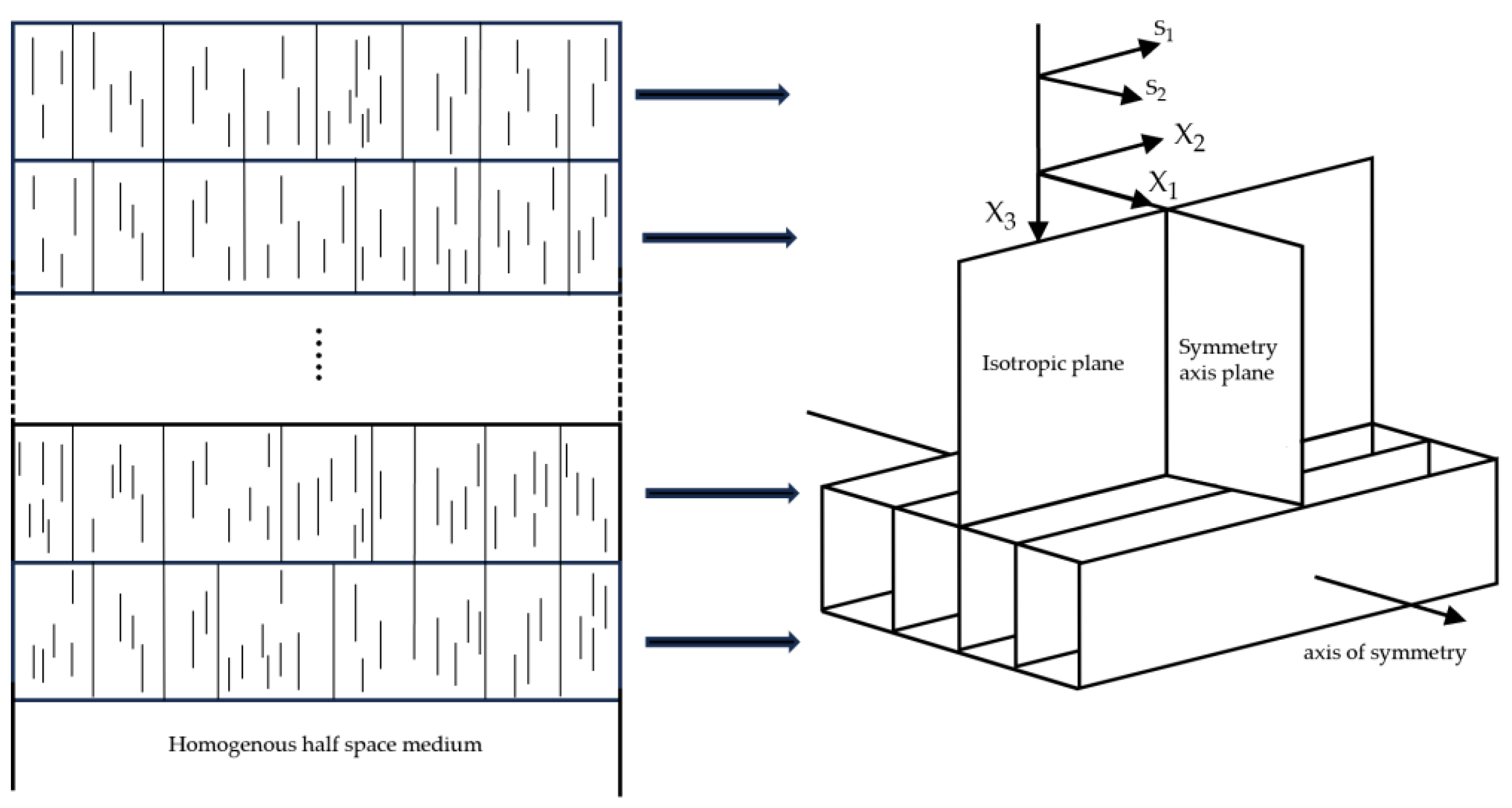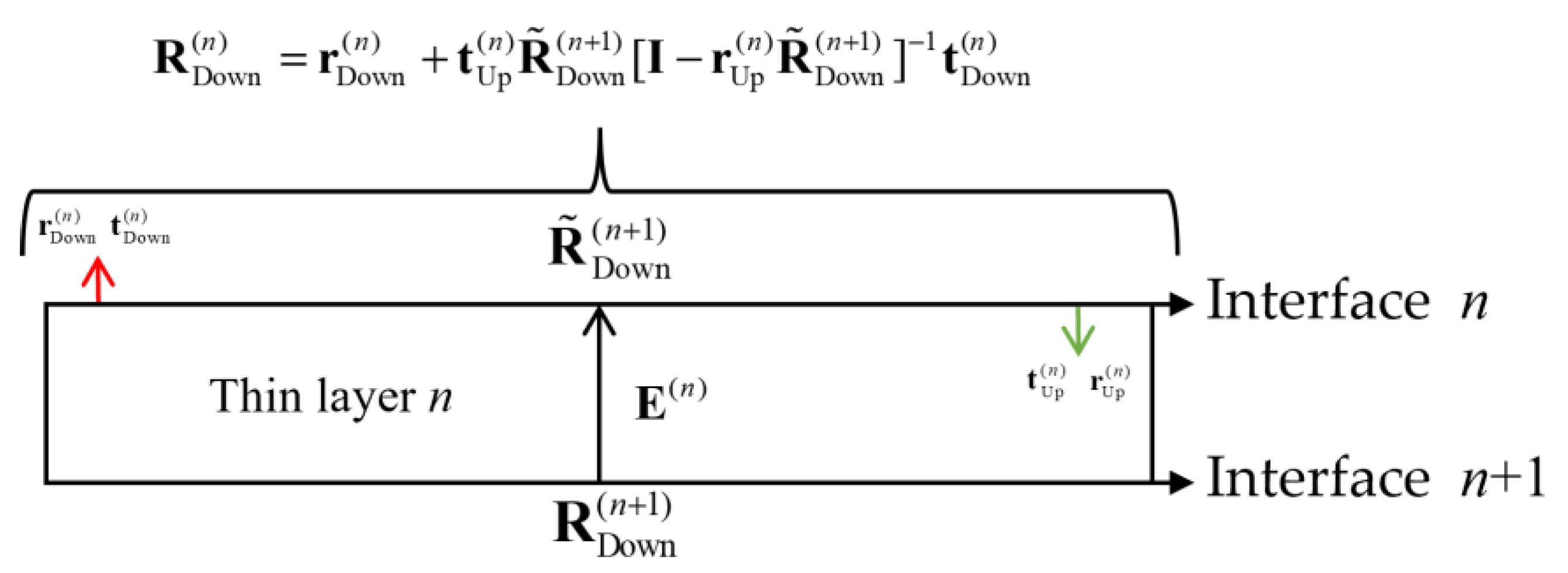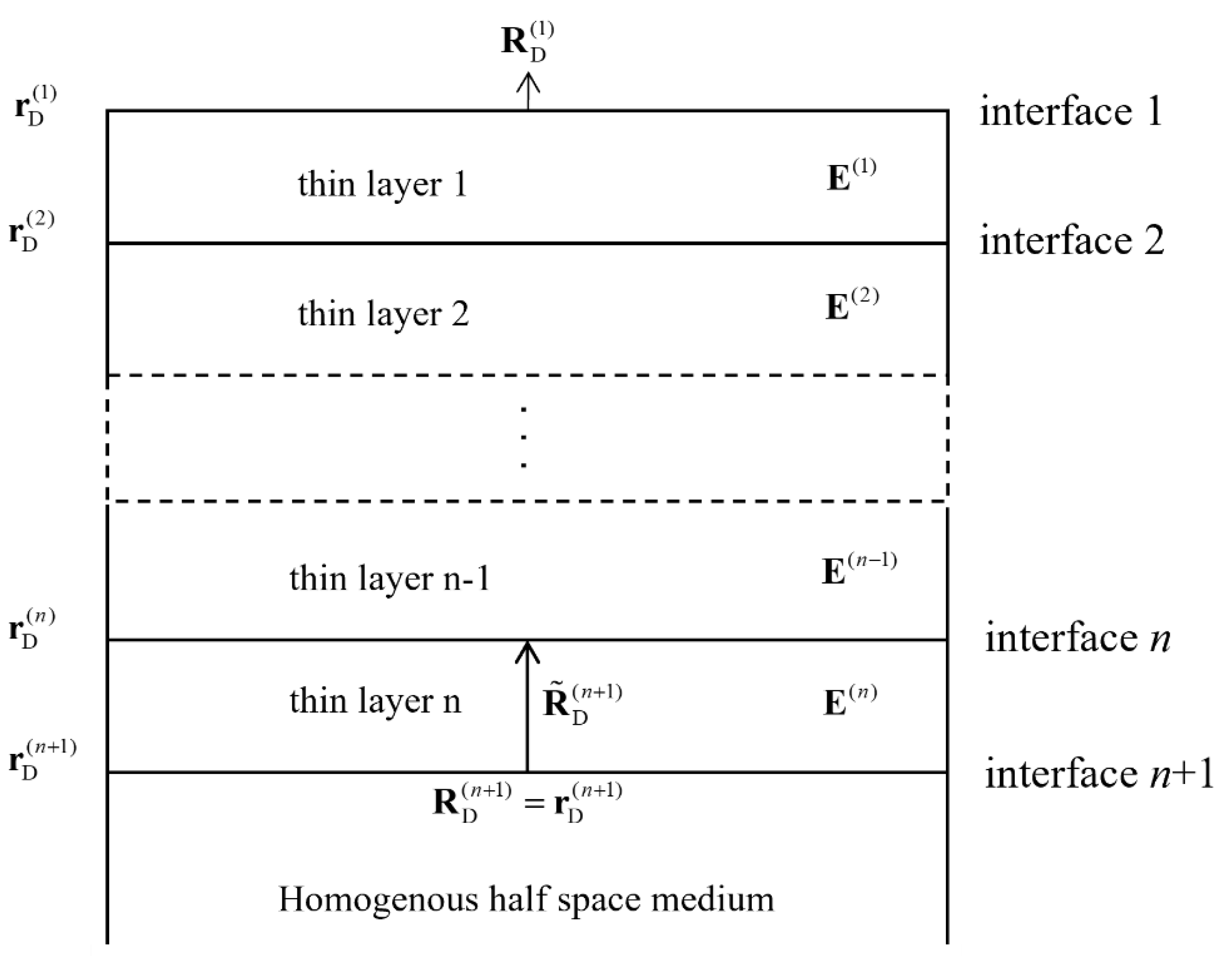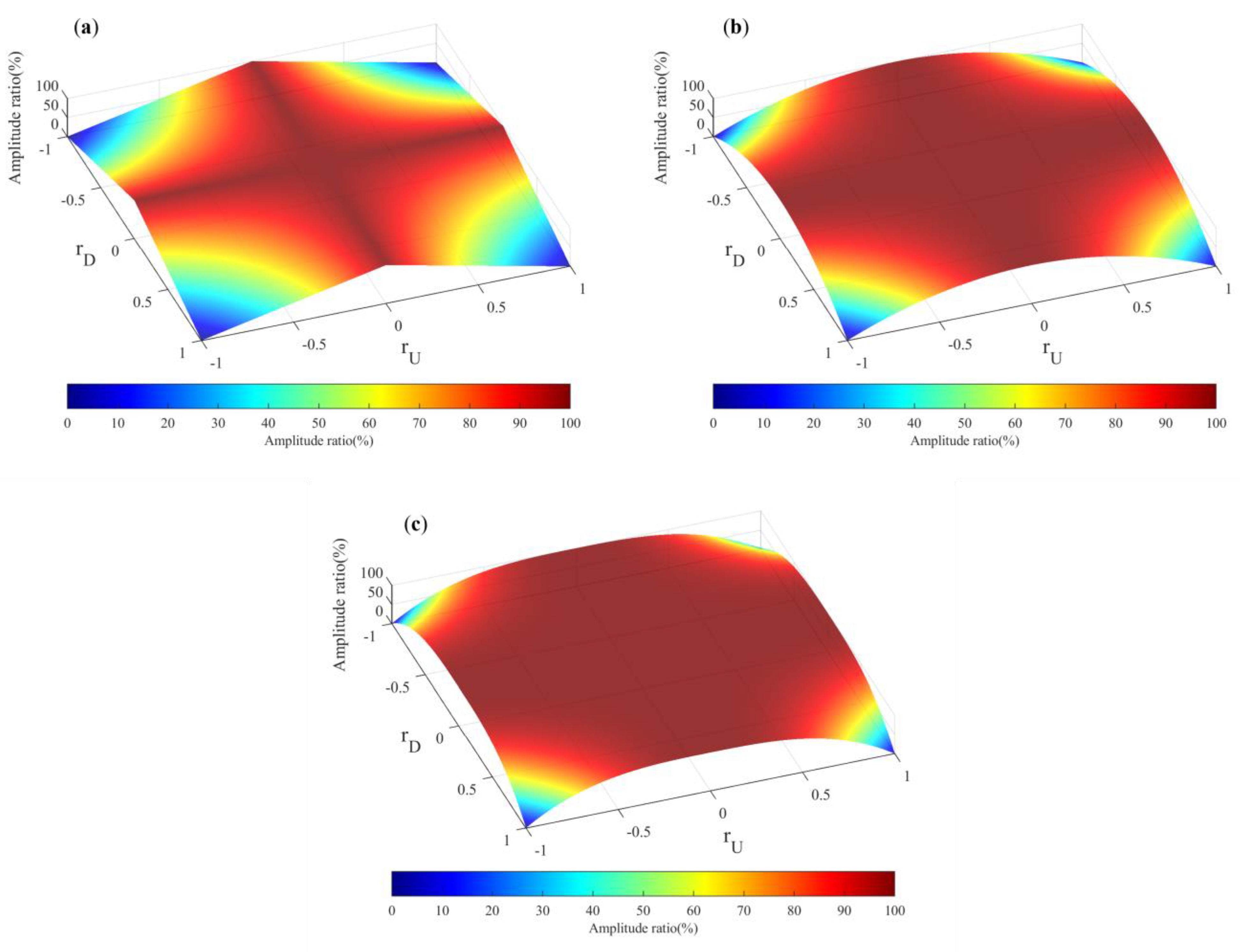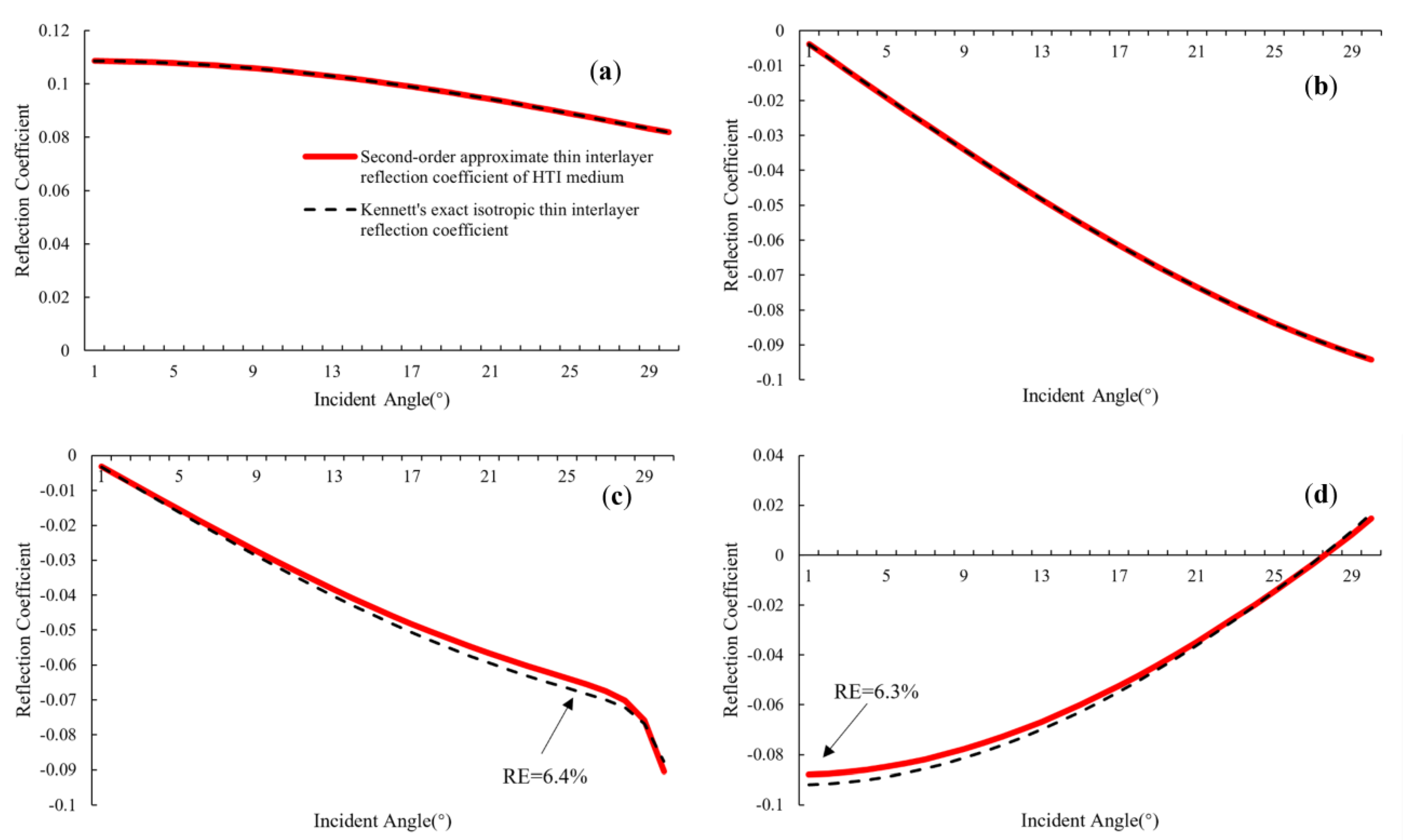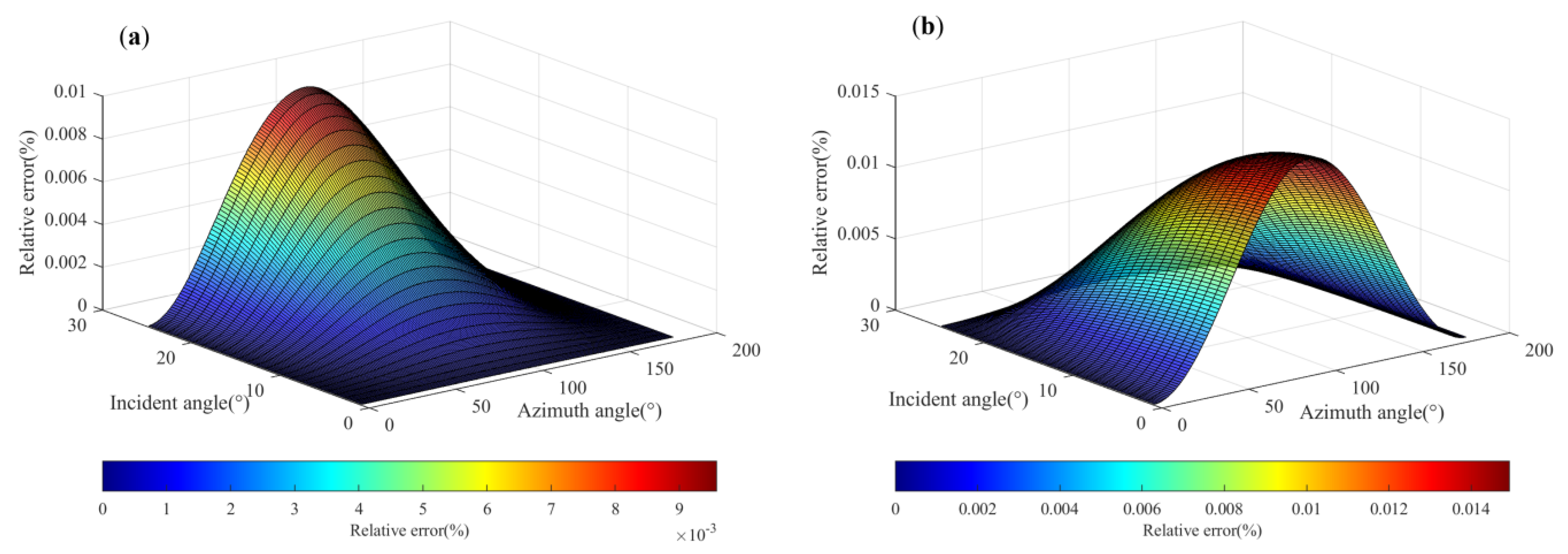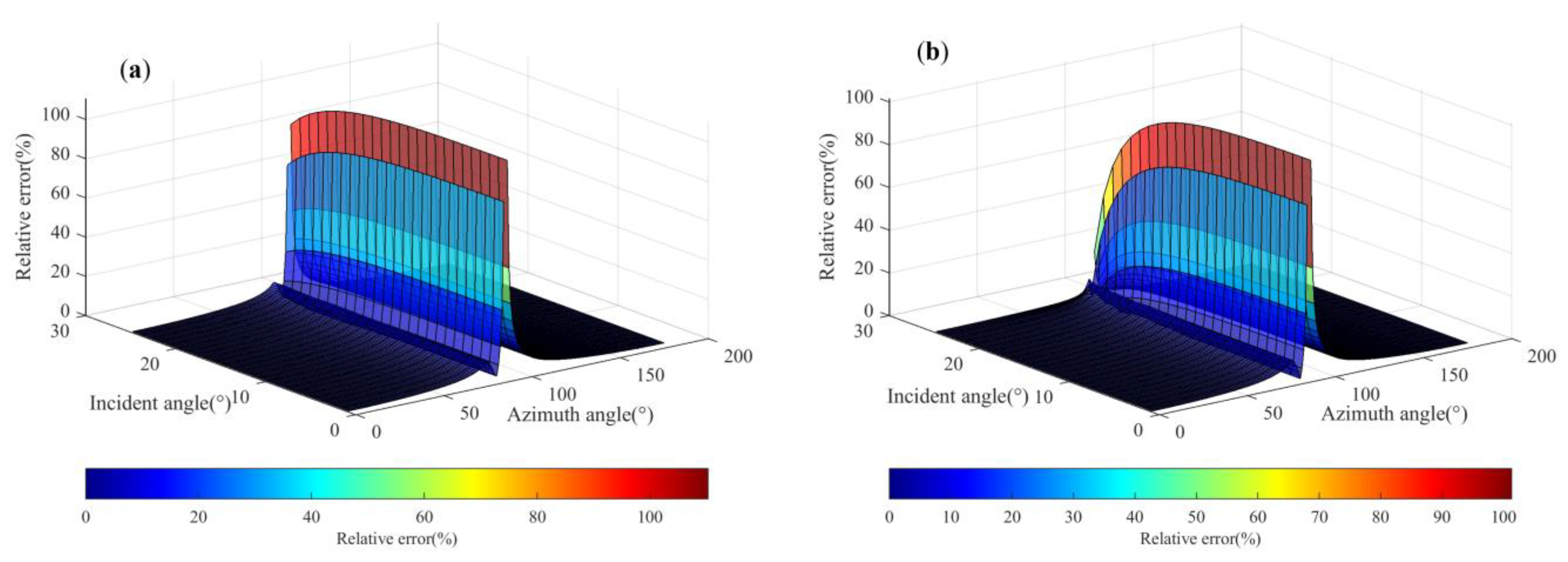2.1. Second-Order Approximate Reflection Coefficient of the Isotropic Single Thin Layer
When solving the reflection coefficient of thin interbeds with widely developed vertical fractures, the single thin layer of interbeds cannot be considered an isotropic medium. We replace the single layer with an HTI medium, shown in
Figure 2. HTI media can be separated into two symmetry planes based on their relative relationship with the fracture surface. One is perpendicular to the fracture surface, and the other is parallel to the fracture surface [
27]. When a shear wave propagates in this anisotropy medium, it will split into two types: the fast shear-wave S1 with the polarization parallel to the fracture surface and the slow shear-wave S2 with the polarization perpendicular to the fracture surface, shown in
Figure 2.
Kennett proposed the reflection coefficient of isotropic layered media [
17,
18], where the reflection coefficient on the top of any layer
n in the interbeds medium is
Yang and Lu proposed a method for calculating the reflection coefficient of layered media based on Kennett [
21]. Under the assumption of small incidence angles and moderate impedance contrasts (
Figure 3), they introduced the reflection coefficient for an isotropic single thin layer in the slowness–frequency domain:
where
I is the unit diagonal matrix of elements, and
and
represent a single interface reflection and transmission coefficient matrices on interface
n for the downward waves, respectively. They can be represented as
and
represent the single interface reflection and transmission coefficient matrices on interface
n for the upward wave waves, respectively. They can be represented as
is total reflection coefficient matrix on interface
n + 1:
is a phase-shift factor of layer
n. It can be represented as
As shown in
Figure 4,
is obtained by phase-shifting the total reflection coefficient matrix
from interface
n + 1 to the bottom of interface
n.
The symbol ω represents the angular frequency in Formula (6), and h(n) represents the thickness of layer n. The vertical slowness of the P-wave and S-wave for layer n can be represented as and .
2.2. Reflection Coefficients of a Single Interface for HTI Media
According to Formulas (1)–(4) in the preceding section, it is obvious that if we want to obtain the total reflection coefficient of any single thin layer n, it is necessary to calculate the single interface reflection and transmission coefficients of the thin layer. We then replace the isotropic term in the isotropic approximate reflection coefficient formula with the anisotropic term in Formulas (1) and (2), transforming the isotropic single interface reflection coefficient in Formulas (1) or (2) into the reflection coefficient of HTI medium.
Rokhlin first proposed a precise reflection coefficient and transmission coefficient of the TI medium for P-waves incident from above the interface [
28,
29]. The incident wave function is
where the symbol
represents the polarization vector of the incident P-wave,
k is the wave number,
n1,
n2, and
n3 are the three components of the normal vector of the wavefront,
, and
x1,
x2,
x3, are the three components of the position vector.
represents the phase velocity of the P-wave incident.
Based on the boundary conditions of stress and displacement continuity on both sides of the interface, we can conclude
When the subscript α = 0, it represents the elastic properties of the incident wave. For α = 1, 2, 3, they, respectively, represent the elastic properties of the reflected P-wave, S1-wave, and S2-wave. Similarly, α = 4, 5, 6 represent the elastic properties of reflected P-wave, S1-wave, and S2-wave, respectively. The superscripts I and II represent the overlying medium and underlying medium at the interface, respectively. The subscript
k = 1, 2, 3 represents the components of the slowness vector along the X
1, X
2, and X
3 directions, and
m stands for slowness.
R represents interface reflection coefficient, and
c represent the elements of the HTI elastic stiffness matrix.
We then converted Equation (8) into a matrix form:
When the wave function Equation (7) incident is downwards from the interface, it can be solved as
However, according to Equations (3) and (4), only the interface reflection coefficient for P-wave downward incidence is not enough. We also need to solve the single-interface reflection coefficient for P-wave upward incidence and S-wave incidence.
From Equations (3) and (4), it can be seen that we not only needed the reflection coefficient of the downward incident P-wave but also the reflection coefficient of the upward incident P-wave and the upward and downward incident S-wave. Therefore, we modified the polarization and phase velocity of the incident wave function (7) to simulate different types of wave incidence. Therefore, based on the calculation approach of Rokhlin P-wave incidence, we extended it to the calculation of the reflection coefficients of various waveforms in HTI media, including upward and downward waves.
When incident P-waves propagate upwards from the bottom of the interface, the incident wave function is
Due to the upward incidence of P-waves, the components
n1 and
n2 of the wavefront propagation direction remain unchanged. Adding a negative sign before
n3 represents the upward incidence from below the interface. The polarization vector
and phase velocity vector
change in the same way as
n, so we just added a negative sign before the component on the X
3 axis. The detailed information for calculating the polarization vector and phase velocity of P-wave, S1-wave, and S2 wave in the HTI medium is shown in
Appendix A.
The interface reflection and transmission coefficient matrix of the single interface can be written as
The wave functions for the upward and downward waves of S1 and S2 wave sources are described as follows:
when the waves are incident on the interface, the reflection and transmission coefficients can be obtained through Equation (9):
The interface reflection and transmission coefficient matrices (3) and (4) can be rewritten as follows:
We modified the single-layer phase shift factor in Formula (6). The detailed information for calculating the phase shift factor of the P-wave, S1-wave, and S2 wave in the HTI medium is shown in
Appendix B. The phase shift factor in the thin interbed of HTI medium should consider the influence of shear wave splitting, such as
where
ω represents the angular frequency,
h(n) represents the thickness of layer
n, and
,
,
represent the vertical slowness of Layer
n’s P-wave, S1 wave, and S2 wave, respectively. We derived the analytical expression for the vertical slowness of HTI media by solving the Christoffel equation [
30]:
where
ρ represents the thin layer’s density;
c11,
c33,
c55, and
c13 are independent stiffness coefficients, which can be determined through VTI parameters [
31,
32,
33].
VP0 and
VS0 represent the P- and S-wave velocities of isotropic surfaces, respectively, s
ε(v),
δ(v), and
γ(v) Represent the Thomsen anisotropic parameter.
2.3. Second-Order Approximate Total Reflection Coefficient of Thin Interbeds with Vertical Fractures
The total reflection coefficient on the top of any nth thin layer within the thin interbeds can be obtained from Equations (21) and (22). We represent Equation (1) with Formulas (21) and (22) as
In order to explain the physical meaning of each part in the above formula, we first expanded the Taylor series in Formula (1):
The convergence region of the Taylor expansion is . Based on the provided elastic parameters such as layer medium wave velocity, density, and anisotropic parameters, we can observe that the absolute values of each element in matrices and are all below 1. The determinant of matrix is consistently less than 1. Therefore, replacing with its mth-order Taylor expansion is reasonable under condition .
Equation (31) is the m-order approximation formula; m can take any positive integer.
We consider m as 3 to expand the above equation:
Each term of the third-order approximation formula has a clear physical meaning in Equation (32). Each term in the reflection coefficient represents a different propagation path of seismic waves. The first term
is the reflection coefficient matrix of a reflected wave on the interface
n, shown in
Figure 5.
In
Figure 6,
illustrates the reflection coefficient matrix for the incident wave that passes through interface
n, and reflect on interface
n + 1, and then transmits back through interface
n. The above-mentioned waves are called primary waves.
As shown in
Figure 7, after completing primary-wave reflection in the thin layer n, the seismic wave does not directly transmit through the interface n. Instead, it continues to reflect within layer n, the reflections of which are called multiples.
First-order multiples: ;
Second-order multiples: ;
Third-order multiples: .
Combining the coefficient expressions for seismic wave propagation on interface
n described in
Figure 7, we can obtain all wave fields:
Formula (33) is the sum of the reflection coefficients of various wave fields under third-order multiples. This equation is completely consistent with Formula (32). This indicates that the order of Taylor expansion is consistent with the order of multiples. We can control the order of multiples by changing m.
Taking the reflection coefficient of a single thin layer that retains third-order and fewer multiples as an example, as shown in
Figure 8, we used Kennett’s reflection coefficient recursion method to iterate layer by layer from the reflection coefficient at the bottom of the thin interbed, and calculated the total reflection coefficient at the top of the thin interbed.
Since our model is based on the homogenous half-space assumption, there was no upward reflection transmission in the bottom half space. Therefore, the total reflection coefficient of the bottom single layer was equal to the single-interface reflection coefficient of the bottom interface:
where
is the contribution term of the reflection coefficient of the
n + 1 interface to the top interface of the
n layer; it can be calculated by
Given , the total reflection coefficient on the top of the adjacent layer n can be obtained as follows:
Similarly, at this point, the contribution term of to the reflection coefficient of the top interface of the n − 1 layer can be determined as . At this time, it can be inferred that the total reflection coefficient of the n − 1 layer and its underlying strata is
Using the above method to recursively push each thin layer to the top of the thin interbeds, the third-order approximate total reflection coefficient of the thin interbeds can be
In order to analyze the energy proportion relationship between multiples of different orders, we chose the recursive method as an example to obtain the total reflection coefficient formula of thin interbeds with vertical fractures. In the reflection coefficient calculation formula, we retained first-order, second-order, and third-order multiples, while ignoring high-order multiples:
The validation model was composed of four layers of 10 m thick HTI medium thin layers. The bottom of the model was an isotropic half-infinite space. The maximum incident angle was the critical angle, while the step size of the incident angle was taken as 0.1°. The azimuth angle of the crack was set to 45°. The density, velocity, and anisotropy parameter information of the thin layer are shown in
Table 1.
As shown in
Figure 9,
Figure 10 and
Figure 11, it is evident that the relative error for the primary reflection coefficients of PP, PS1, PS2, S1P, S1S1, S1S2, S2P, S2S1, and S2S2 waves, in comparison to the reflection coefficients retaining first-, second-, and third-order multiples, was consistently below 0.1%. There is almost no difference between the four approximate reflection coefficients regarding retaining different order multiples.
The above indicates that under the model in
Table 1, retaining multiples of different orders has little effect on the total reflection coefficient of thin interbeds with fractures. In order to verify the energy proportion relationship between different-order multiples in other models, we used the reflection coefficient on a single interface as a variable to simulate the energy relationship between different-order multiples in different thin-layer models.
Since the energy of a wave is proportional to the square of its amplitude, we analyzed its energy by studying the amplitudes between different-order multiples.
Based on the physical description of the multiples’ expression in a thin layer, we assumed that the amplitude of the incident wave was Ainc, and the reflection coefficient of the primary wave in the thin layer was RPrim, while the reflection coefficient of first-order multiples in the thin layer was RMuti. (RPrim: , RMuti: ).
The amplitude of a primary wave in a thin layer is
The amplitude of seismic waves reflected by second-order multiples within a thin layer is
The amplitude of
m-order multiples in a thin layer is
If infinite-order multiples are retained, i.e.,
m tends towards infinity, then the amplitude is
Since the reflection coefficient is between −1 and 1, when
m tends to infinity,
tends to 0:
The ratio of the amplitude energy of first-order multiples to the amplitude energy of all multiples can be written as follows:
The ratio of the amplitude energy of second-order multiples to the amplitude energy of all multiples can be expressed as
The ratio of the reflection amplitude of multiples within the third-order to the reflection amplitude of all multiples can be written as
We can also draw the ratio of the seismic wave reflection amplitude of the first-order multiples with different conditions to the amplitude of all multiples in
Figure 12.
In
Figure 12a, it shows that when both of the absolute values of the reflection coefficients of upward
and downward
on a single interface are both less than 0.07, the energy of first-order multiples will occupy over 95% of the total energy. When the absolute values of
and
are greater than 0.2, the energy of higher-order multiples can exceed 15%. The absolute values of the reflection coefficients of the thin interbeds were less than 10
−3 in this model, so the energy of the first-order multiples always accounted for the main part of the energy of multiples. As shown in
Figure 12b, the energy of first-order and second-order multiples accounts for 98–99% of the high-order multiples in this model (absolute values of
and
both less than 0.1). In
Figure 12c, it shows that the third-order and low-order multiples also account for over 99% of the total wave field amplitude, which is not significantly different from the results in
Figure 13. When the absolute value of the thin-layer interface reflection coefficient is above 0.45, the energy of third-order and above multiples should be considered.
However, the reflection coefficient of actual strata rarely exceeds the degree to which third-order multiples need to be considered. Therefore, when calculating the reflection coefficient of thin interbeds with fractures, we mostly used a second-order approximation formula:
